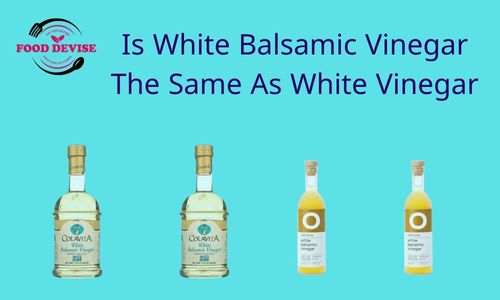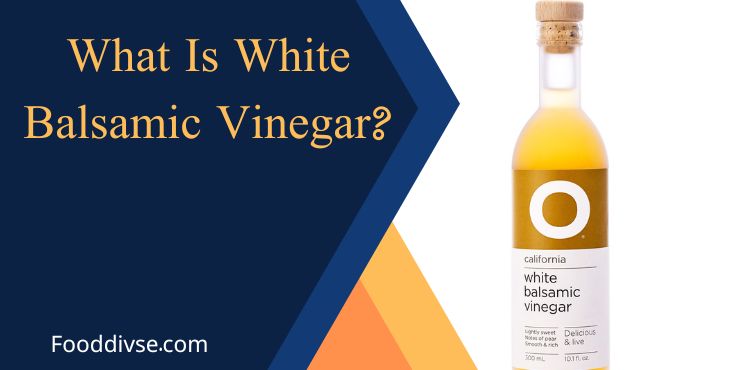Like all other types, white balsamic vinegar is one of the most popular. This is not like other types of vinegar. Besides the color of this vinegar, some other features also make it a different thing. But many people don’t have any idea about this vinegar.
What is white balsamic vinegar? This is a type of vinegar that is made in a special way to make it white. Sometimes white grapes are used to make it. Besides its color, there are some more specialties in this vinegar.
This is a discussion where we are going to talk all about white balsamic vinegar and its health benefits. Besides that, we will try to compare this and normal balsamic vinegar. So, without any delay, let’s start.
What Is White Balsamic Vinegar?
White balsamic vinegar is a type of vinegar made from white grapes, rather than the traditional dark grapes used to make traditional balsamic vinegar. The white grapes are typically Trebbiano or Sémillon varieties.
The juice is then cooked at a low temperature, and the resulting vinegar is aged for a shorter period of time than traditional balsamic vinegar. This results in a lighter color and a milder flavor, making it a versatile ingredient in salad dressings, marinades, and sauces.
Sometimes the black grape also helps to make this vinegar. In that case, a special procedure is followed to remove the color and make it white.
What Is White Balsamic Vinegar Made Of?
White balsamic vinegar is made from a blend of white grape must and wine vinegar. The must, or juice, is cooked at a high temperature to reduce its volume and concentrate the flavors. It is then blended with wine vinegar and aged for a shorter period of time than traditional balsamic vinegar. This results in a lighter color and a milder, less sweet flavor than traditional balsamic vinegar.
What Is White Balsamic Vinegar Used For
White balsamic vinegar is a versatile ingredient that can be used in a variety of ways in cooking and baking. Some common uses include:
- Salad dressings: White balsamic vinegar can be used to make a light, tangy salad dressing when combined with oil, mustard, and herbs or spices.
- Marinades: White balsamic vinegar can be used to add flavor and tenderize meat, fish, and vegetables when used in marinades.
- Glazes: White balsamic vinegar can be reduced down to make a sweet and tangy glaze for meats, fish, and vegetables.
- Sauces and dips: White balsamic vinegar can be used to make sauces and dips, such as aioli, vinaigrette or pesto.
- Baking: White balsamic vinegar can be used in baking to add a subtle sweetness and tanginess to cakes, cookies, and other desserts.
- Drinks: White balsamic vinegar can also be used in making cocktails and mocktails.
It’s also a great ingredient for adding a subtle tangy note to any dish without altering the color, which makes it a great ingredient for many fish, chicken, and white meat preparations. This is what white balsamic vinegar is used for.
Is This Vinegar Good For You?
White balsamic vinegar is considered to be a healthy addition to a balanced diet. It is lower in calories than traditional balsamic vinegar and has a milder flavor. It is also a good source of antioxidants, which can help protect the body from damage caused by free radicals.
Additionally, it can be used to dress salads, marinate meats, and as an ingredient in sauces and dressings. However, it’s always best to consume it in moderation, as consuming excessive amounts can lead to acidity.
Is White Balsamic Vinegar The Same As White Vinegar?

White balsamic vinegar and white vinegar are not the same. This vinegar is made from a blend of white grapes, typically Trebbiano and Sauvignon Blanc, which are cooked and aged to create a sweeter and milder flavor than traditional balsamic vinegar.
White vinegar, on the other hand, is made from diluted grain alcohol, typically corn, barley, or beets. White vinegar is typically used for cleaning, pickling and cooking because of its strong and sharp taste. It is also more commonly used in food as a condiment for salad dressings and marinades.
Here is a comparison table of normal Balsamic Vinegar and White Balsamic Vinegar:
| Feature | Normal Balsamic Vinegar | White Balsamic Vinegar |
| Color | Dark brown | Light yellow or clear |
| Flavor | Strong and complex | Mild and sweet |
| Acidity | High (6-8%) | Medium (5-6%) |
| Production process | Slow aged (minimum of 12 years) | Quick aged (only few months) |
| Grapes used | Trebbiano and Lambrusco | Trebbiano and Sauvignon Blanc |
| Ideal for | cooked dishes, meat, cheese | salads, fish, light colored sauces |
| Price | High | Medium |
Note that this is a general comparison table, and the actual composition and taste of balsamic vinegar can vary depending on the producer, aging process, and grapes used.
Conclusion
Now we can say, white balsamic vinegar is a versatile and unique ingredient that can add depth and flavor to any dish. It is made from a blend of white wine vinegar and unfermented grape must, which gives it a sweet and tangy taste.
Unlike traditional balsamic vinegar, white balsamic vinegar is not aged and has a lighter color and flavor. It can be used in a variety of ways, such as salad dressings, marinades, and sauces. Hope you find the necessary info here. That was all for today. Thanks.

Hello, my name is Lora J Fusco, and I am a passionate chef with a wealth of experience in the culinary world. I am not in the kitchen making meals. I love to share my insights and adventures by writing on my blog.
Food and cooking are not just my job but also my passion. I am thrilled to have the chance to connect with you through my writing. Welcome to my space, and I hope you enjoy exploring the wonderful world of food with me!

